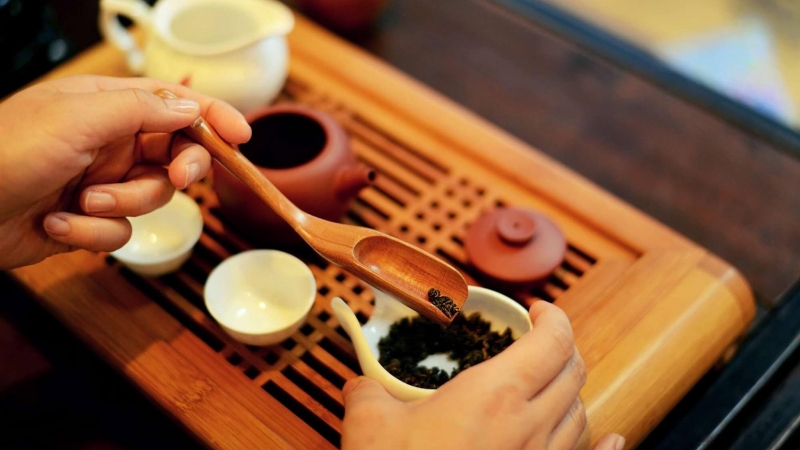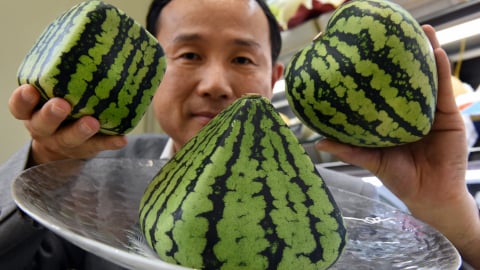There are mornings when the first rays of sunlight are still hesitant to penetrate the foliage, we put on a pot of boiling water, listening to the sound of the water and the aroma of a handful of dry tea leaves seems to have the weight to dispel the lethargy of the early morning. In that moment, we understand that the art of enjoying tea is not just a ritual, but a way for people to find the slow rhythm of the soul in this too fast world.
Tea in any culture has always been a symbol of stillness. From the stone steps of Kyoto, where the Japanese tea ceremony turns pouring a cup of tea into a meditative ritual, to the ancient houses of Hanoi, where the scent of West Lake lotus tea gently dissolves in 85-degree boiling water... all share the same spirit: we are honoring the stillness and slowness in modern life.

People talk about tea in the language of benefits, rather than emotions and culture.
The scent of tea is imbued with the taste of time
Vietnamese people have long considered tea a part of their spiritual life. Before coffee or wine, people had a cup of hot tea in the morning, a cup of tea to invite guests to their home, or a pot of jasmine tea brewed hastily at noon. Each type of tea is a memory, each flavor is a different way of telling a story of the land and people.

From young leaves to dry tea strands - a journey of fragrance, sunlight and diligent hands
Lotus tea - the "queen" of Vietnamese teas is not only beautiful in its fragrance but also in the way the ancient Hanoians cherished it. A West Lake lotus is hand-scented with handfuls of Thai Nguyen green tea, repeated for seven nights, so that the lotus scent gradually permeates each strand of tea like a union between the quintessence of heaven and earth. Just a light sip, the tea has a pure, sweet aftertaste, as if we are touching a culture imbued with the spirit of Hanoi, both delicate, calm and extremely profound.
In the East, tea is not only a drink but also a way. Since the Tang Dynasty, the Chinese have called tea “the tranquility of the mind”, a means to maintain the balance between yin and yang. The Japanese have turned tea ceremony into an art of living, where every gesture of pouring water and inviting guests carries the concept of “harmony, respect, purity, tranquility”. Perhaps that is why, just by watching a Japanese tea master turn a teapot, we can feel the rhythm of tranquility, where everything is no longer an action, but a meditation. Although the Vietnamese do not call tea a “way”, there is still a way in the way we drink it. It is simple, rustic, and does not require elaborate rituals. A teapot (tea making tools), a handful of raw tea, a few close friends, that is enough to make people’s hearts pure.

Lotus tea - the essence of lake lotus and mountain tea, where the fragrance awakens every sense. Photo source: Tra Vu - tea artisan
When modern life sweeps away the ancient scent of tea
In the 21st century, cups of coffee with a global feel gradually replaced the traditional teapot. Tea was pushed back into a small corner of modern life as a beautiful but old image. Cups of water taken away in the spirit of "take away" or cups of water delivered to the door in the hurried pace of life made people lose the habit of sitting down, waiting for the water to boil, watching the tea leaves gradually change. In offices that are lit all night, tea was reduced to "detox drinks" or "beauty drinks".
But tea has never been something to “drink quickly for health”. It is a slow journey from boiling water, waiting for it to boil, to taking a sip and feeling the aftertaste spread. In the modern world, letting tea culture fall into oblivion is something that we all regret. Tea, by nature, does not need to compete with coffee, milk tea, wine, beer. It is already a part of Vietnamese cuisine, of Vietnamese spiritual culture and is a simple, familiar drink, close to our old life.

The artisan not only makes tea, but also keeps alive a cultural trait that has accompanied the Vietnamese people for generations. Photo source: Tra Vu - tea artisan
The stillness in tea is exactly what modern life is lacking. As technology makes everything more convenient, people need a “pause”, a ritual to return to themselves. And perhaps, brewing a pot of tea in the early morning or in the middle of a noisy afternoon is how we redefine “personal time” - the greatest luxury of this century.
Tea - the subtle language of modern life
In every tea ceremony, from the Japanese tea ceremony to the Vietnamese tea room, there is an unchanging principle that the tea is delicious only when the mind is calm. Boiling water at the right temperature makes the tea delicious, but if the mind is in a hurry, the cup of tea may be weak. The ancients said: "First water, second tea, third pot, fourth pot, fifth group of friends" but in fact, the most important factor is still "mind". Making tea is an art of stillness. When you pour boiling water into the teapot, hear the sound of tea leaves waking up, smell the scent of orchids in the air, that is a moment of meditation. Tea does not teach us to show off or show off, but teaches us to listen more, to the sound of running water, to the rhythm of breathing, to the quiet that is sown in our hearts.
In today’s globalized world, tea is not just a beverage, but a symbol of refined taste. In Tokyo, brands like Sakurai Japanese Tea Experience transform the tea ceremony into a contemporary art experience where light, space and sound are designed to maximize the multi-sensory experience. In London, afternoon tea in grand hotels and tea shops remains a symbol of elegance, where mint tea sets and Earl Grey tea are served with scones and classical music.


In Vietnam, the art of tea is gradually reviving in a new way. The young generation is looking for handmade tea, lotus-scented tea, and local herbal tea. Many modern tea shops such as An Gia Vi, Tan House, or Ngoa Van Am in Hanoi have recreated the tea-drinking space with a slow and peaceful tea spirit. Tea here is not a commodity just for sale, but for people to have a space to learn and interact with Vietnamese tea culture. Each pot of tea is a conversation, each wisp of smoke is a stream of thought, and it seems that no one wants to commercialize tea too much. Because perhaps tea teaches us to be moderate, to wait, to respect every little moment. From adjusting the water temperature to pouring just enough, it is a lesson in delicacy and patience. A good cup of tea, after all, is the result of harmony between nature and the soul of the tea drinker.
Tea becomes a global bridge
Tea, although born in the East, has become a drink of the whole world. The British turned it into a symbol of the aristocracy. The French considered it a part of cuisine. The Japanese and Koreans considered it a philosophy of Zen. The Chinese considered tea an art of enjoyment. And the Vietnamese, after many historical changes, still keep for themselves a unique tea soul that is rustic, discreet but profound.
Nowadays, Vietnamese tea has begun to step out into the wider world. From West Lake lotus tea, Ha Giang Shan Tuyet tea, Thai Nguyen green tea to B'Lao tea or Bao Loc Oolong tea... it has been noticed by the international culinary world not only for its flavor but also for the cultural story behind it. Many famous fine dining chefs have begun to use Vietnamese tea in pairing menus. They have tried combining lotus tea with steamed fish or green tea with yuzu-flavored desserts. Tea and tea culture are gradually reborn not as a heritage but more vibrant, closer and more everyday.


Tea, although born in the East, has become a drink of the whole world.
The beauty of tea is that it transcends boundaries. Whether you drink it from a ceramic cup, a crystal goblet, or even a paper cup, tea carries the same essence as an invitation to slow down and listen to yourself.
Interestingly, the more modern people become, the more they crave ancient values. Tea is being “reborn” in trendy spaces from boutique tea rooms in Paris to modern minimalist tea shops in Seoul. In Vietnam, the trend of enjoying tea in a modern way is also gradually taking shape. Young artisans such as Tran Phi Vu (Societea), Truong Le An (An Gia Vi) or Nguyen Thu Trang (HACOOCHA)... have organized many tea making workshops, teaching how to make tea, about temperature, about water, about the mindset when drinking tea. Or other tea masters in Vietnam are also on the way to bring tea to young people.

A cup of tea - a slow moment. Amidst the noise, we find peace in the spreading aroma of tea. Photo source: Tra Vu - tea artist
Amidst the hustle and bustle of modern life, the art of tea still exists as a mirror reflecting the soul. When we make tea, we are also learning to get acquainted with an aspect filled with culture and imbued with the spirit of Asia. And perhaps, in today's noisy world, a cup of fragrant tea, a minute of silence, a space that allows us to slow down is the greatest luxury that modern people can give themselves.

 EN
EN



































